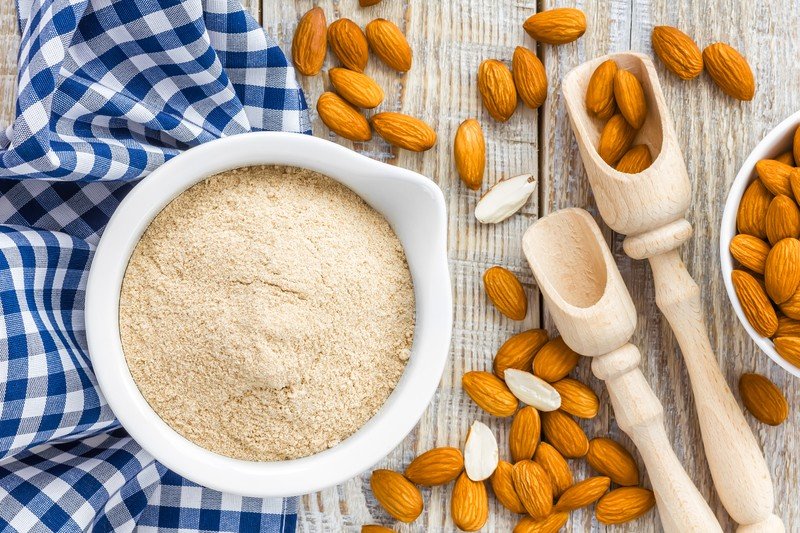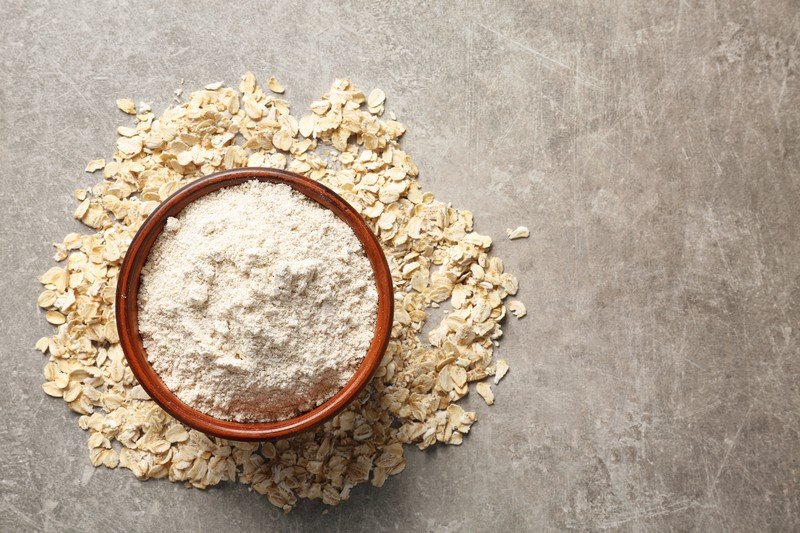Almond flour is not like traditional flour from wheat. It’s almonds into a flour-like texture. It’s a great source of healthy fats and protein, however, lower in carbs compared to standard wheat flour, and higher in fat.
Because of that, it gives brownies, muffins, and bread tender and moist texture. Almond flour can be an issue if you’re allergic to nuts. Almond flour won’t work like regular flour in baked recipes. Thus, it’s not a 1:1 substitute.
I’ve been working with almond flour for many years converting regular recipes to grain-free and the other way around. I’ve learned what can be used as a substitute for almond flour.
You can substitute almond flour with wheat flour, all-purpose flour, cashew flour, macadamia flour, sunflower seed flour, oat flour, and more.
Almond Flour Substitutes
Almond flour is popular in many keto, paleo, and grain-free kitchens. Furthermore, many recipes are modified to meet those specific lifestyles.
However, if you don’t have almond flour on hand, you can use some of the following substitutes.
1. Wheat flour
Almond flour can be replaced with whole or refined flour, but this can increase the carbohydrate content of the food and reduce the flavor.
Plus, wheat flour is lighter than almond flour, so you will need to use more than the required amount for almond flour.
2. All-purpose flour
As a substitute for almond flour, you can use all-purpose flour. For 1 cup of almond flour, you may use 1 cup of all-purpose flour. Yet, the amount may shift depending on the recipe. Almond flour usually asks for extra eggs or other binding ingredients, so you have to decrease that quantity if you’re utilizing all-purpose flour.
3. Cashew flour
Finely ground nut flours created of blanched nuts are often utilized in gluten-free recipes. If you don’t have almond flour, use cashew flower instead. It’s perfect for muffins, cookies, and elegant cakes. It also blends well into savory and sweet baked things.
4. Macadamia flour
Almonds have more carbs than macadamia nuts. For example, 100 g of macadamia nuts has 13.83 g carbs while 100 g of blanched almonds have 18.67 g carbs.
Therefore, macadamia flour is very good for the Paleo diet(elimination or reduction of cereal grains like rice, corn, oats, barley, rye, and millet, refined or whole), in regular diet, gluten-free diet, or any other health and specialty diets. The results are very similar.
5. Sunflower seed flour
100 g of sunflower seed flour (partially defatted) has 35.83 g carbs, 1.61 g total fat, 48.06g protein, and 326 calories according to the USDA. It’s loaded with different minerals, vitamins, and fiber (5,2 g). Thus, sunflower seed flour is an ideal nut-free alternative for almond flour.
Use finely ground and filtered flour. You may need to utilize half the required amount of baking soda in the recipe. Essentially, you may need to double the measure of cream of tarter. The acidic cream can keep the food from becoming green because of chlorophyll present in the seeds.
6. Oat flour
You can put rolled oats in a high-speed blender or food processor until they turn to dust. You can get 3/4 cup oat flour from a single cup of rolled oats.
If you have chosen a without gluten formula, utilize confirmed without gluten oats. You can use oat flour instead of almond flour and give your cake awesome nuttiness and lightness.
7. Combination of tapioca and coconut flour
Coconut flour is a great non-grain gluten-free flour just like almond flour. It has a wonderfully fruity and sweet flavor, rich in fiber, good fats, and protein. Tapioca flour is made from cassava root and is very stretchy like gluten. Therefore it can be used as a great binding ingredient.
In place of 2 cups of almond or wheat flour in a recipe, you can use 1 cup of tapioca flour and 1 cup of coconut flour. Coconut flour absorbs a lot of liquid (almond flour introduces extra moisture), so the batter can look like hardened cement.
If you want to keep the batter soft and moist you have to add 5-6 eggs (double the amount of eggs in a recipe), or liquids like coconut milk, apple sauce, fruit juice, a mashed up banana, etc. The choice is yours to experiment with.
Each flour has its arrangement of advantages and disadvantages. If you are supplanting the almond flour with gluten-free flour, it will not generally be a cup-for-cup substitution. Amounts can vary, and you may need to add other chemical agents like xanthan gum or guar gum.
With the experimentation technique, you will know the right proportion of the almond flour substitute, baking soda, eggs, other flours, and liquids. Baking time also needs to be adjusted.
Maybe gluten-free cakes may not be fluffy as traditional wheat cakes, but they will be full of wonderful flavors and textures. Baking is a science so it is best to approach it with an open mind.
If you are a beginner use only tried recipes or with less than 2 cups of flour. Experienced culinary cooks may begin exploring different recipes regarding plans that call for more flour.
8. Homemade gluten-free flour blend
For certain recipes, utilizing a gluten-free flour mix can be useful with regards to tracking down a substitute for almond flour. On the off chance that you need to prepare gluten-free flour mix, you will need:
- ⅔ cup potato starch
- 2 cups of rice flour
- ⅓ cup tapioca starch
- 1 teaspoon xantham gum
Gluten-free flours also need extra moisture and thickeners like xanthan gum or guar gum so don’t forget to use them.
This blend is good for all kinds of baked goods, especially chocolate chip cookies. You can use the appropriate amount of flour and save the rest in an airtight container.
9. Banana flour
Banana flour is loaded with vitamins and minerals. Rich in potassium, magnesium, zinc, and other essential minerals, it can help lower your cholesterol levels naturally, boost brain and heart health, and aid nerve activity. This flour is rich in resistant starch which is good for those suffering from diabetes.
10. Make almond flour
Nut flour has a high oil content and will go rotten rather rapidly. It is ideal to make it in a clump for your particular recipe. Experts recommend utilizing a portion of the flour or sugar called for in the recipe when mixing the flour. This assists with keeping the flour from being warmed and getting oily.
Put 2 tablespoons of flour or sugar and nuts in a blender with a sharp blade. Your old blender probably is not suitable for the job if you’ve never changed out the blade.
Use a food processor instead. Simply beat the blender or food processor on and off until the nuts are ground to an even consistency. Try not to expect an entirely refined surface since nuts don’t pound evenly.
Related Questions
Can you substitute almond flour for regular flour?
Almond flour is somewhat moister than wheat flour and doesn’t have incredible same restricting characteristics. You’ll do best to substitute 1:1, regardless, as numerous plans react well to this immediate substitution. In any case, be set up to add more almond flour as you go to make up for the wetter batter.
Can I replace almond flour with coconut flour?
Coconut flour additionally can be utilized as a substitute for almond flour in a recipe. Coconut flour can supplant almond or wheat flour in any recipe. You will likewise have to add 1 egg for each 1/4 cup of coconut flour utilized notwithstanding the eggs called for in the original recipe.
Does almond flour take longer to bake than regular flour?
Baked goods with almond flour take longer to bake than wheat flour recipes.
How do I substitute almond or coconut flour for all-purpose flour?
When you don’t have almond or coconut flour on hand, use 1:1 with all-purpose flour. Almond flour typically requires extra eggs or a binding agent. Therefore, the recipe needs to be changed.
Let’s Bake a Cake!
Experiment with these substitutes and get innovative in the kitchen. My family cherishes when I have a go at something new, and I LOVE keeping things healthy and grain-free, so it’s a shared benefit. Have you attempted any of these options in contrast to almond flour and coconut flour? Which is your top choice?








2 comments
don’t see any comments, but your info is so helpful that I wanted to say ‘thanks’. A lot of allergies and gluten-free in and of itself has its learning curve, so I at least feel you’ve given me some guidelines so I can experiment and correct instead of throwing up my hands in defeat! Again, appreciate your knowledge/sharing/
Thank you we are going to try a few of these flours.